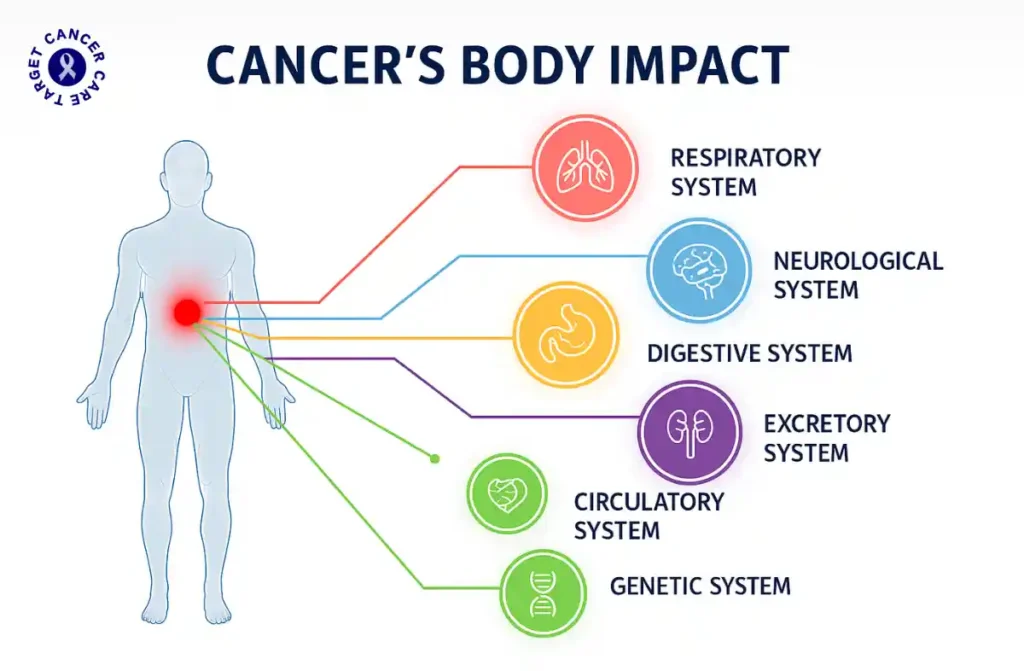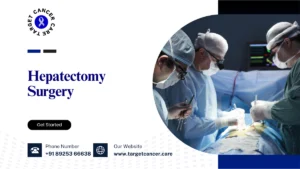Cancer is a life-altering condition that impacts not only the body but also the mind and emotions. Understanding how is the body affected by cancer can shed light on the physical, emotional, and societal challenges faced by those diagnosed. At Target Cancer Care, our mission is to provide clarity, support, and expert care to help patients navigate this journey.
What is cancer?
Cancer is a group of diseases in which cells grow uncontrollably, ignore normal stop signals, invade nearby tissues, and may spread to distant organs. These abnormal cells acquire genetic and epigenetic changes that let them divide faster, avoid cell death, and recruit blood supply. Understanding how is the body affected by cancer helps explain why symptoms vary so widely across organs and individuals. What body system does cancer affect often depends on the tumor’s origin (e.g., lung, breast, blood) and its pattern of spread, as well as the person’s baseline health.
Signs and Symptoms of Cancer
- General constitutional changes. Persistent fatigue, unintentional weight loss, night sweats, or low-grade fevers are common early clues. These reflect metabolic demands of the tumor and inflammatory signals—key parts of how is the body affected by cancer at a whole-body level.
- Organ-specific warning signs. Cough that doesn’t resolve, chest discomfort, breathlessness, or coughing blood may indicate a lung origin. These illustrate how is the body affected by lung cancer, where airway blockage, inflammation, or fluid around the lungs impairs oxygen exchange.
- New lumps or changes in the breast or skin. A hard, fixed breast mass, nipple inversion, peau d’orange skin, or unexplained skin lesions warrant evaluation. Such features show how is the body affected by breast cancer through local tissue distortion and inflammatory changes.
- Neurological symptoms. Persistent headaches, seizures, weakness, or balance problems can occur when tumors arise in the brain or spread there. Pressure on neural structures and swelling disrupts normal signaling and function.
- Pain or fractures without significant trauma. Bone metastases weaken the skeleton and cause deep, aching pain, often worse at night or with movement. Microscopic erosion of bone increases fracture risk and calcium release into the blood.
- Blood clots and recurrent infections. Some cancers increase clotting tendencies, leading to leg swelling or sudden chest pain from pulmonary emboli. Tumors and therapies can suppress immunity, another dimension of how is the body affected by cancer.

How does cancer affect the body?
Cancer alters organ structure, drains energy, misguides hormones and immune responses, and can seed new growths elsewhere. At its core, how is the body affected by cancer reflects a tug-of-war between the tumor’s demands and the body’s capacity to maintain balance.
- Local invasion and organ failure. Tumors can compress airways, block ducts, erode bone, or obstruct intestines, producing pain and loss of function. Over time, even small changes in a critical location (e.g., brainstem) can have major consequences.
- Systemic inflammation and immune disruption. Tumors release cytokines that cause fatigue, appetite loss, and muscle wasting; immunity may be suppressed or misdirected. This dysregulation also increases infection risk and complicates wound healing.
- Metabolic hijacking and cachexia. Cancer cells rewire metabolism to fuel rapid growth, diverting calories and breaking down muscle and fat. This energy imbalance is a classic example of how is the body affected by cancer beyond the tumor site.
- Paraneoplastic and endocrine effects. Some tumors produce hormone-like substances that cause high calcium, low sodium, or nerve and muscle problems. These effects may appear far from the original tumor, confusing the clinical picture.
- Hematologic consequences. Cancers infiltrating marrow crowd out normal blood formation, leading to anemia, bleeding, or infection. Circulating tumor factors can also make blood hypercoagulable.
What impact does cancer have on the body?
What body system does cancer affect may include the respiratory, digestive, nervous, circulatory, lymphatic, endocrine, or musculoskeletal systems—sometimes several at once. Clinically, how is the body affected by cancer spans organ failure, reduced stamina, emotional stress, and treatment-related side effects.
- Breathing and oxygenation. Tumors can narrow airways, stiffen lung tissue, or cause fluid around the lungs, lowering oxygen levels and exercise tolerance. These features summarize how is the body affected by lung cancer, often presenting as progressive breathlessness and chronic cough.
- Breast and chest-wall function. Masses may tether skin, alter lymph flow, and cause pain with arm movement or sleep. Such functional limits capture how is the body affected by breast cancer, including lymphedema after surgery or radiation.
- Digestion and nutrition. Cancers of the mouth, esophagus, stomach, liver, or pancreas impair swallowing, absorption, and enzyme function. Weight loss, vitamin deficiencies, and altered bowel habits can follow, even before treatment begins.
- Fertility and hormones. Tumors or therapies can affect ovaries, testes, thyroid, or adrenal glands, changing cycles, libido, or sperm counts. This is another real-life face of how is the body affected by cancer, extending beyond the primary organ.
- Bones and movement. Bone metastases lead to pain, fractures, and high calcium, while some treatments thin bone density. Mobility programs and bone-protective agents help preserve independence.
- Nervous system and mood. Cancer can compress nerves or spread to the brain, causing weakness, numbness, or seizures; stress and inflammation can contribute to anxiety or depression. Supportive care, counseling, and symptom control are vital.
How does cancer spread from one part of the body to another?
- Breaking free and entering vessels. Tumor cells loosen their attachments, digest surrounding tissue, and slip into nearby blood or lymph vessels (intravasation). This mobility is a pivotal step in how is the body affected by cancer when localized disease evolves into systemic illness.
- Survival in circulation. Circulating tumor cells travel with platelets and clot proteins that shield them from immune attack. Only a small fraction survive the turbulence and immune surveillance of the bloodstream.
- Exiting vessels and colonizing new sites. Cells attach to distant vessel walls, exit (extravasation), and adapt to the new organ’s environment. They recruit local cells, coax new blood vessels to grow, and form metastases that can overwhelm organ function.
How does cancer affect the blood and circulatory system?
The circulatory system transports oxygen, nutrients, immune cells—and, unfortunately, tumor cells. As tumors grow or therapies begin, how is the body affected by cancer often includes blood and vessel changes that influence fatigue, bleeding, clotting, and heart health.
- Marrow crowding and anemia. When cancers invade bone marrow, red blood cell production falls, causing pallor, shortness of breath, and rapid heartbeat. This pattern is central to how is the body affected by leukemia, where malignant white cells displace normal blood formation.
- Infections and bleeding from low counts. Low neutrophils increase infection risk, while low platelets cause easy bruising or nosebleeds. Again, how is the body affected by leukemia is evident in recurrent fevers, mouth ulcers, and prolonged bleeding from minor cuts.
- Clotting disorders and thrombosis. Many tumors release pro-coagulant factors that heighten the risk of deep vein thrombosis and pulmonary embolism. Swelling of one leg or sudden chest pain warrants urgent medical attention.
- Heart and vessel effects. Some therapies can weaken heart muscle or raise blood pressure, and chest radiation may stiffen vessels over time. Baseline cardiac assessment and ongoing monitoring reduce long-term complications.
How does cancer affect the lymphatic system?
- Lymph node enlargement and filtration overload. Nodes trap tumor fragments and immune complexes, becoming enlarged and sometimes tender. Enlarged nodes can compress nearby structures, altering sensation or causing swelling.
- Lymphedema and fluid balance. Removal or scarring of lymph nodes disrupts drainage, leading to chronic limb swelling, heaviness, and skin changes. Gentle exercise, compression, and specialized therapy help restore function.
- Immune surveillance changes. Tumors may dampen antigen presentation and T-cell activation within lymph tissues. This blunts recognition of abnormal cells and increases susceptibility to infections.
- Pathway for spread. Many carcinomas migrate first through lymphatics before entering the bloodstream. Mapping and sampling “sentinel” nodes helps determine stage and tailor therapy.
What are the treatments for Cancer?
- Supportive, palliative, and rehabilitative care. Pain control, nutrition, infection prevention, and physical and occupational therapy improve comfort and function at any stage. Emotional support and symptom relief are part of high-quality, person-centered care.
- Surgery. Removal of the primary tumor cures many early-stage cancers and relieves symptoms from blockage or bleeding. Minimally invasive and organ-preserving approaches aim to maintain function while achieving clear margins.
- Radiation therapy. High-energy beams damage tumor DNA, shrinking or eradicating tumors with careful planning to spare healthy tissue. Techniques such as IMRT, SBRT, and proton therapy allow precise dosing around critical organs.
- Systemic therapy: chemotherapy, targeted therapy, and immunotherapy. Chemotherapy attacks rapidly dividing cells; targeted drugs block specific molecular drivers; immunotherapy re-energizes the immune system against cancer. Combinations are chosen based on tumor type, stage, and biomarkers.
- Hormone and endocrine therapies. For hormone-sensitive tumors (e.g., breast, prostate), reducing or blocking hormones slows growth. Side-effect management and bone protection are integral parts of care.
- Cellular and advanced therapies. Options such as CAR-T cells and tumor-infiltrating lymphocytes harness living immune cells to attack cancer. These require specialized centers and careful monitoring for immune-related effects.
- Precision medicine and clinical studies. Molecular profiling can reveal actionable mutations and eligibility for novel treatments. Enrolling in well-designed studies can provide access to innovative options while contributing to progress.
Conclusion
Understanding how is the body affected by cancer provides a foundation for awareness, prevention, and treatment. At Target Cancer Care, we are committed to offering comprehensive care and support for every patient. Whether you or a loved one is facing cancer, our team is here to guide you every step of the way.
Read also Hepatectomy Surgery.




